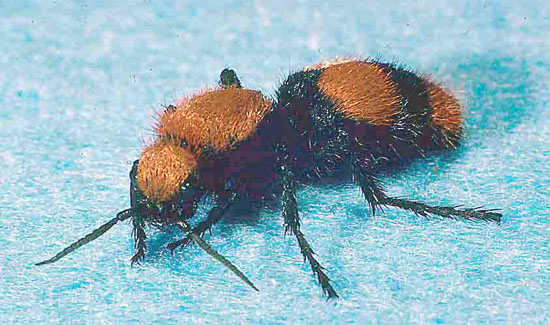Issue 12, July 16, 2010
Cicada Killer and Velvet Ant
Cicada killers are becoming numerous in turf areas. Adult cicada killers are large wasps, about 2 inches long and black, with yellow band-like marks. The head and transparent wings are brownish red. Females dig burrows that are one-fourth to one-half inch in diameter with loose soil next to the hole. They tend to prefer sandy and bare soil areas.

Application of permethrin or other labeled insecticide to the burrowed area should kill the female cicada killers in golf course sand traps. Individual burrows in dry areas can be treated by applying carbaryl (Sevin Dust) alongside burrows where the female wasp will track through it. She will be killed after ingesting the dust while grooming. If sand boxes, volleyball courts, and other infested areas can be covered with a tarp during many of the daylight hours, the cicada killers will leave without the need for insecticide use. When the females are killed or leave, the similar-appearing males will leave.
Most velvet ant species are brightly colored. Females of the most obvious species in Illinois are about 1 inch long, wingless, and bright orange-red with black bands. They run quickly and nervously about in dry, sandy areas and on sidewalks, where they are easily noticed. The males are colored similarly to the females but have transparent, black wings. As with cicada killers, male velvet ants cannot sting, as the stinger is a modified egg-laying device.

Velvet ants are parasites of cicada killer and bumblebee nests. Mated female velvet ants enter host nests to lay their eggs. The resulting larvae eat the young of the cicada killers or bumblebees, spend the winter as pupae in the nest, and emerge during the following growing season.--Phil Nixon
Author:
Phil Nixon